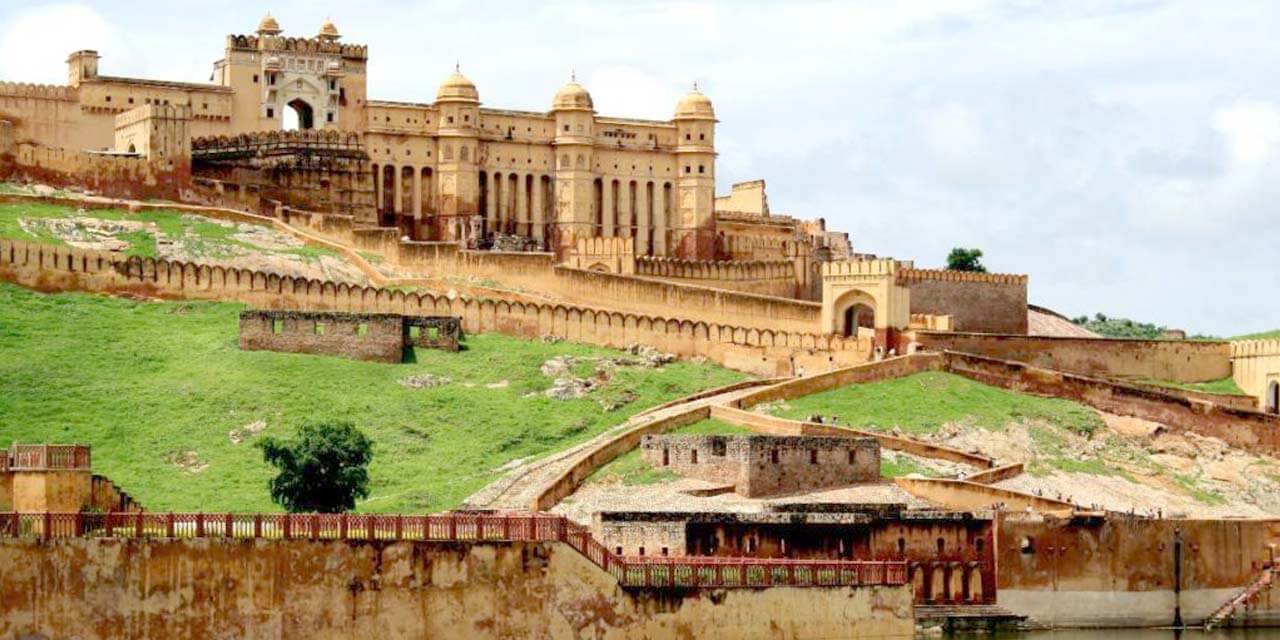Loading...
Majestic hilltop fort-palace with stunning architecture, intricate mirror work, and panoramic views of Maota Lake and the surrounding hills.

Amber Fort, also known as Amer Fort, is one of the most popular heritage sites in Rajasthan. It is located 11 kilometers from Jaipur city and sits on a hill overlooking Maota Lake. Built in 1592 by Raja Man Singh I, the fort represents Rajput military strength and royal lifestyle. Today, it is a UNESCO World Heritage Site and welcomes thousands of visitors every day.
The construction of Amber Fort began under Raja Man Singh I, a commander in the Mughal army. Later rulers such as Raja Jai Singh I and Sawai Jai Singh II expanded the complex. Before Jaipur was founded, Amer served as the capital of the Kachwaha Rajputs. The fort grew over the centuries into a grand palace complex with courtyards, temples, and halls. Its history reflects the military strategy and cultural richness of Rajputana.
Amber Fort is built with red sandstone and white marble. Its design combines Rajput and Mughal styles. The complex is divided into four main sections, each with courtyards and gateways. Walls are decorated with frescoes, carvings, and mirror work. The layout balances defense features with royal luxury, making the fort both strong and beautiful.
Visitors enter through Suraj Pol, the Sun Gate. It leads into Jaleb Chowk, the main courtyard where soldiers once assembled.
Ganesh Pol is a painted gateway that opens into the royal quarters. It is decorated with images of Lord Ganesha and floral designs.
Diwan-i-Aam was the Hall of Public Audience. Here the king listened to the people. Diwan-i-Khas was used for meetings with nobles and featured detailed marble inlay work.
Sheesh Mahal, or the Mirror Palace, is the most famous hall. Thousands of mirrors reflect even the smallest light, creating a starry effect. Sukh Niwas was designed as a cool retreat with water channels that kept the chambers pleasant in summer.
The Zenana, or women’s quarters, housed queens and royal women. Its interconnected rooms and latticed windows offered privacy while allowing ventilation and views.
Maota Lake lies at the foot of the fort. It was the main water source for the fort and its gardens. The reflection of Amber Fort on the lake creates a stunning view at sunrise and sunset. A saffron garden, Kesar Kyari, was once planted on the lake’s island.
Amber Fort attracts thousands of visitors daily. During peak tourist season between October and March, the number often exceeds 5000 visitors per day. The fort is one of the most visited sites in Rajasthan along with City Palace and Hawa Mahal.
In the evening, a light and sound show narrates the history of Jaipur and Amber. The illuminated walls of the fort provide a dramatic backdrop. The show is available in both Hindi and English, making it popular with Indian and international visitors.
Amber Fort is well connected to Jaipur city. Visitors can reach the fort by car, taxi, or auto rickshaw. From the base of the hill, options include walking, hiring a jeep, or taking an elephant ride to the gate. Jaipur Metro improves connectivity, with Chandpole and Sindhi Camp stations serving as the nearest points before continuing by road.
Amber Fort was included in the group of Hill Forts of Rajasthan recognized as a UNESCO World Heritage Site in 2013. The Archaeological Survey of India and heritage bodies oversee conservation. Restoration projects focus on preserving frescoes, carvings, and mirror work for future generations.
The best months to visit Amber Fort are from October to March. The weather is cooler and more comfortable for exploring. Early mornings and late afternoons provide the best light for photography and a less crowded experience.
Opening Hours
8:00 AM - 5:30 PM
Closed On
None (Open all days)
Time Required
2-3 hours
Best Time to Visit
Early morning to avoid crowds and heat
Address
Devisinghpura, Amer, Jaipur, Rajasthan 302028